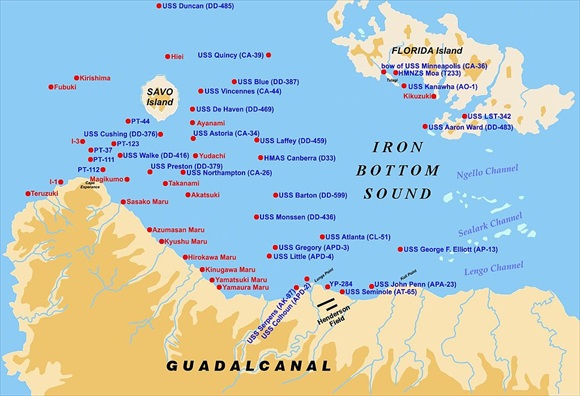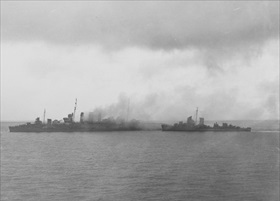ALLIED AND JAPANESE NAVIES IN FIERCE BATTLE
Off Guadalcanal, Solomon Islands • August 8, 1942
A United States naval task force carrying Maj. Gen. Archibald Vandegrift’s First Marine Division arrived off Guadalcanal, in the eastern Solomon Islands, on the morning of August 7, 1942, and launched Operation Watchtower, the first American offensive of World War II. Two days later the Marines had captured the uncompleted Japanese airfield at Lunga (renamed Henderson Field) on Guadalcanal, the primary target of their invasion, as well as islands to the north of and around Tulagi harbor in the Florida Islands (see map below). The Lunga airfield, had it been operational, would have threatened American communications with Australia and New Zealand.
On this date, August 8, 1942, the Imperial Japanese Navy, quickly responding to the Allied amphibious landings on Guadalcanal and Tulagi islet, mobilized a small surface fleet of 5 heavy cruisers, 2 light cruisers, and a single destroyer under the command of 53‑year-old Vice Adm. Gunichi Mikawa. The newly formed Eighth Fleet set out from two island bases, Rabaul and Kavieng, in Japanese-occupied Papua New Guinea, racing southeastward down the long and narrow New Georgia Sound, soon to be known as “the Slot,” that bisected the Solomon Islands archipelago. Mikawa’s intention was to interrupt the American landings by attacking not only the 18 Allied invasion transports disembarking troops and supplies but their protective screening force of U.S. and Australian warships as well.
The Allied screen, one group guarding the northern approach to Guadalcanal, the other the southern approach, totaled 8 cruisers and 15 destroyers under 48‑year-old British Rear Admiral Victor Crutchley, but only 5 cruisers and 7 destroyers were involved in the ensuing Battle of Savo Island. In night action in the vicinity of Savo Island, a volcanic cone 5 miles long by 2 miles wide north of Guadalcanal, Mikawa’s fleet ambushed and routed much of the Allies’ two screening forces, fatally damaging four heavy cruisers, the HMAS Canberra, the USS Quincy, USS Vincennes, and USS Astoria, while suffering minor damage to 3 Japanese cruisers in the vicious 30‑minute brawl. In triumph Mikawa fled the scene of carnage, leaving the unarmed American transports, loaded with vital supplies, untouched in their anchorages off Guadalcanal and Tulagi.
The First Battle of Savo Island has often been cited as the worst defeat in a fair fight in the history of the U.S. Navy. The battle was one of five costly, large-scale sea and air-sea actions fought in support of the ground battles on Guadalcanal itself, as the Japanese sought to counter the American offensive in the Pacific. Four of the battles are consecutively numbered owing to their common location near Savo Island and occurred in October and November 1942. The fifth naval battle, the Battle of Rennell Island, took place on January 29–30, 1943, 130 miles south of Guadalcanal, by which time the Japanese were preparing to withdraw and evacuate their remaining land forces.
The Guadalcanal Campaign (August 7, 1942, to February 9, 1943) not only ended all Japanese expansion attempts in the Southwest and Central Pacific and placed the Allies in a position of military supremacy, but it was a serious blow to Japan’s strategic plans for the defense of their homeland. It is safe to say that Japanese reverses on and around Guadalcanal, as yet underappreciated by Tokyo’s military leaders though not by America’s, were the first in a string of forced retreats that eventually led to the surrender of Japan in September 1945 and the American occupation of the Japanese Home Islands.
![]()
Allied Naval Debacle: Battle of Savo Island, August 8/9, 1942
 |
Above: The Battle of Savo Island, also known as the First Battle of Savo Island, was one of four naval battles in the straits, later named Ironbottom Sound, between the large island of Guadalcanal (2,047 sq. miles), tiny Savo Island, and Florida Island (Nggela Sule). In this map the names of Japanese shipwrecks are indicated in red lettering (18 in all); Allied shipwrecks (32 in all) are indicated in blue. (Japanese sources remember the naval battle as the First Battle of the Solomon Sea.) Among Allied Guadalcanal veterans the Battle of Savo Island was colloquially known as The Battle of the Five Sitting Ducks. It took place over August 8–9, 1942, and was a Japanese victory over a mix of American and Australian warships. The Allied debacle cast a pall over the Allies’ Guadalcanal Campaign (Operation Watchtower, August 7, 1942, to February 9, 1943) practically through the end of 1942, when Allied warships (principally U.S. Navy ships) fought Japanese naval units in one October engagement (Battle of Cape Esperance, also known as the Second Battle of Savo Island, October 11–12, 1942), and two November engagements, the Naval Battle of Guadalcanal (November 12–15, 1942), a strategic U.S. victory, and the Battle of Tassafaronga, November 30, 1942, a tactical U.S. defeat. The November naval engagements are sometimes referred to as the Third and Fourth Battles of Savo Island.
 |  |
Left: Apparently down by the stern, the cruiser USS Quincy is illuminated by Japanese cruiser Aoba’s powerful searchlights and pummeled by accurate torpedo and shellfire, the Japanese navy’s reward for hard training for night battles and having superior equipment. (U.S. heavy cruisers were not outfitted with torpedoes, and the torpedoes on other U.S. warships did not match the reliability, speed, range, and accuracy of the oxygen-fueled Japanese Long Lance, which carried a thousand pounds of deadly explosive.) The attack was so fast and fierce that many Quincy crewmen never got to their battle stations. The flames in the far left of the picture are probably from USS Vincennes, also on fire from gunfire and torpedo damage. The Quincy, whose hull had been shredded, and the Vincennes, hit by 56 large-caliber shells and 6 torpedoes, were two of four Allied cruisers lost off Savo Island in the predawn hours of Sunday, August 9, 1942. Quincy sank at 2:35 a.m., 52 minutes after Vice Adm. Mikawa launched his well-planned night attack, and Vincennes sank at 2:50 a.m., 30 minutes after Mikawa abruptly ordered his strike force to withdraw. Last of the American warships to slip under the surface was the USS Astoria early that afternoon, fires raging unchecked and ammunition caches still exploding. A fifth cruiser, the USS Chicago, was hit by a Japanese destroyer-launched torpedo during the nighttime battle and, spewing oil, withdrew for repairs to her damaged bow. In less than 12 hours 1,077 American and Australian sailors had been killed (some eaten by sharks) and 708 wounded, in start contrast to the 129 the Japanese lost. The Savo Island debacle so overwhelmed Adm. Earnest J. King, Commander in Chief, United States Fleet, that he delayed relaying the news to President Franklin D. Roosevelt for a time.
![]()
Right: The Royal Australian Navy heavy cruiser HMAS Canberra fired only a few rounds in her defense before being immobilized by two torpedoes (one may have been friendly fire) and a Japanese barrage of 8‑inch shells to the bridge and engine rooms, occasioning her 10‑degrees list to starboard and setting off multiple internal fires. U.S. Navy destroyers are seen here rescuing survivors (84 had perished) from the sinking Canberra. The U.S. destroyer Blue is alongside Canberra’s port bow as the destroyer Patterson approaches from astern. Despite heroic efforts, Canberra’s crew could not save her. Wracked by explosions and fire, she was sent to a watery grave a little after 8 a.m., August 9, 1942, following an onslaught of 368 rounds of 5‑inch shells and 5 torpedoes from two U.S. destroyers, Selfridge and Ellet.
Battle of Savo Island, August 8/9, 1942: America’s Greatest Defeat at Sea
![]()

 History buffs, there is good news! The Daily Chronicles of World War II is now available as an ebook for $4.99 on Amazon.com. Containing a year’s worth of dated entries from this website, the ebook brings the story of this tumultuous era to life in a compelling, authoritative, and succinct manner. Featuring inventive navigation aids, the ebook enables readers to instantly move forward or backward by month and date to different dated entries. Simple and elegant! Click
History buffs, there is good news! The Daily Chronicles of World War II is now available as an ebook for $4.99 on Amazon.com. Containing a year’s worth of dated entries from this website, the ebook brings the story of this tumultuous era to life in a compelling, authoritative, and succinct manner. Featuring inventive navigation aids, the ebook enables readers to instantly move forward or backward by month and date to different dated entries. Simple and elegant! Click 











